Respond Faster With On-the-Go Technology
August 18, 2020 by Devin Culham

For public safety agencies in Rockwall, Texas, having a streamlined, integrated system is a critical factor in interdepartmental collaboration.
Although the Texas town of approximately 50,000 residents has long been a proponent of utilizing technology in its daily operations, the area's public safety leaders recognized there were opportunities for improvement, specifically surrounding situational awareness and safety for fire crews.
Due to the nature of the position, personnel managing bulky laptops while en route to a reported incident was not always feasible in every fire apparatus. Because of this, fire crews primarily relied on radio communication to determine who would respond to a given location.
"Before, the guys were having to pay attention," said Brett Merritt, assistant chief of Rockwall. "If they heard a call and they were close to it, then they would have to tell dispatch to call."
Although functional, this system had areas in need of optimization.
Primarily, dispatchers and fire crews were heavily relied on to make critical decisions with limited data available. En route and on-site reporting times were often subjected to human error. Once on-site, dispatchers and command staff had limited visual awareness regarding the position and safety of crew members.
To remedy this, Rockwall sought a solution that could communicate with its public safety solutions already in use. By selecting software integrated with the agency's current computer aided dispatch (CAD) program, Rockwall was able to ease the decision-making faculties of dispatchers and provide mobile support to crews in the field.
"I think it's good because they can see the officers safely at a residence," shared assistant chief and fire marshal Ariana Kistner, regarding the new software implementation. "You don't have to verbalize it over the radio. It pops up on the dispatcher’s screen.
The results for Rockwall speak for themselves. Since implementation in 2018, dispatch to first en route times have decreased by 16%. Similarly, the agency's dispatch to arrival times have decreased by as much as 10%.
"Not only are we getting the closest apparatus, but the closest apparatus that can actually fulfill the need of the call type," said Chris Minckler, IT analyst for Rockwall PD.
For Rockwall dispatchers, knowing the mobile location of units gives personnel more information to respond to each reported incident, which means, when and where to dispatch apparatuses equipped to respond to various scenarios such as brush fires, infrastructure fires, or EMS.
Ultimately, the integration between CAD and mobile applications has proven to be an essential feature to improve the agency's workflow, according to public safety IT manager John Bader.
"Having that full suite of products in the application definitely makes our job more efficient, more accurate,” said Bader.